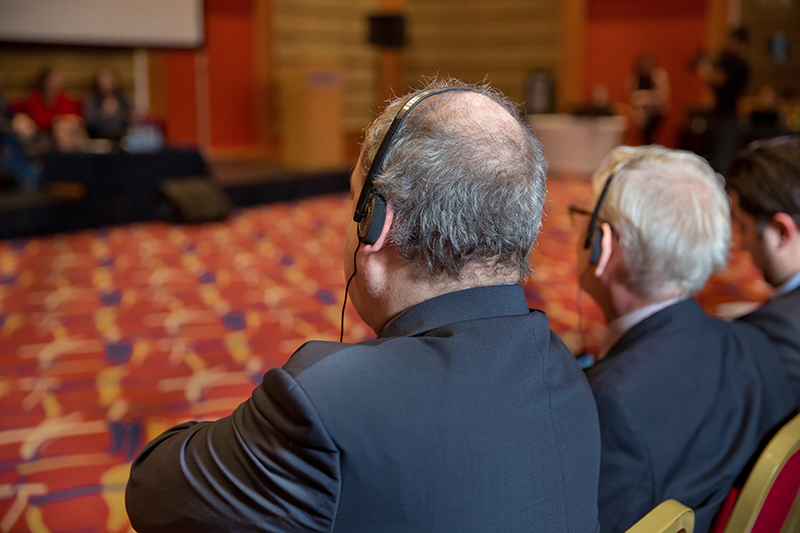Your organization is planning a big event. Perhaps it is a conference, a convention, or maybe a webinar that will deliver critical information to clients, prospects, or employees. What happens when the language of your event is not one that is well understood by the participants? Event interpretation may very well be the difference between a successful event, and one which proves unproductive – at best – for many in your audience.
You may have contracted for event interpretation services in the past, or perhaps this is something new that your organization is going to need. Either way, it’s critical for you to understand the basics of event interpretation. This blog shares:
- What event interpretation is
- What the benefits of working with a company that offers a turnkey interpretation solution are
- What are the latest event interpretation trends
Let’s get started!
What is the Difference Between On-Site and Remote Interpretation?
There are two types of interpretation: on-site interpretation, and remote interpretation. Understanding the key similarities and differences between these can help you determine which interpretation option best meets your needs.
On-site interpretation takes place at the physical location of an event. Interpreters are present to communicate the presenter’s spoken information from one language into another, and vice-versa. This requires the use of a soundproof booth, allowing interpreters not only to hear what needs to be interpreted, but also to witness the speaker’s delivery.

Conversely, remote simultaneous interpretation (RSI) does not require an interpreter to be in the same room as the speaker and audience. Instead, audience members use headphones to listen to the speaker and hear the information in their own language, in real time.
One of the biggest advantages of RSI is that it eliminates the need for interpreter travel expenses and the use of special equipment. It is also a tech-savvy and innovative solution for organizations that are interested in being at the forefront of the latest technology.
Both interpretation styles are effective at ensuring that the linguistic needs of a multilingual audience are met. Engaging the services of a professional interpretation service provider can assist you in making the best decisions when planning your event.
Event Interpretation: Interpro’s Value-Add
Interpro offers a turnkey solution that organizes your workflow from start to finish. Working with a professional service provider eliminates guesswork and closes gaps. Our team understands each step of the interpretation process. From event logistics and technology needs, to language translation and special day-of considerations, our experienced team will help you plan, troubleshoot and succeed.
These benefits are obvious, but there is always room for improvement. Following these guidelines will help make the entire process as smooth as possible for your organization.
1. A Project Manager is key to a successful event.
One of the major benefits of working with a professional interpretation company such as Interpro is having an experienced Project Manager running the show. Your Project Manager understands the scope of work from one milestone to the next, and sees to every detail in order to ensure that the entire event runs according to plan. Additionally, your PM serves as the main point of contact between the interpretation team and your organization as event preparations unfold.
An on-site PM interacts directly with event participants, and helps facilitates support and other communications throughout the course of your event. Having on-site project management and technical support is crucial, whether interpretation is delivered on-site or through RSI. Attendees’ needs are met personally and promptly – delivering impeccable customer service – and the interpreters are allowed to focus on the task at hand, all a testament to your organization’s level of professional service and client service.
2. Don’t forget support materials.
As you plan your event, it is only natural that the focus be primarily on the content each speaker will deliver. However, it is also important to consider support materials as early on as possible. That means determining the type of ancillary visuals and other reference materials that each speaker will use, such as workbooks, pamphlets, brochures, or handouts.
Providing these reference materials to the interpreters as far in advance as possible allows for effective preparation, and ultimately higher quality interpretation. This is yet another way to guarantee an optimal event experience for your audience.
3. Get the layout in advance.
Content is the heart of your event. What is shared may very well make a lasting impact on your audience. In addition to focusing on the “what” side of preparations, you need to consider the “where” for event interpretation engagements.
In fact, doing an advance site visit of the venue to see the rooms and spaces that will be used is extremely beneficial as the number of rooms and attendees can have a direct impact on the scope of your interpretation project. Communicating the details concerning your venue from the onset is crucial.
It is also worth noting that having the interpretation in one room is usually ideal. If multiple sessions requiring interpretation run concurrently, the number of interpreters and on-site representatives needed will increase. A concurrent schedule will also require involve additional technology considerations, as well as more space.
4. Not all booths are created equal.
For on-site event interpretation engagements, two basic types of booth options are typically available:
- Soundproof booths
- Tabletop booths
Soundproof booths are full-size, fully enclosed booths used to provide complete sound insulation. These booths enable interpreters to efficiently perform their job without interfering noises from external sources. Tabletop booths feature an open back that provides partial sound isolation coverage. More portable than soundproof booths, tabletop booths accommodate two interpreters, but do not provide the same level as soundproofing as do soundproof booths. Both, however, are suitable for a wide variety of event settings.
5. Two heads are better than one!
This old adage certainly applies to interpretation. As interpreters are paired by subject matter expertise and experience, working as a pair, they are able to seamlessly take turns interpreting what the speakers are saying.
More importantly, since simultaneous interpreting demands so much concentration and effort, most professional interpreters can only work effectively for periods of 20 minutes or so. After that, they need to hand off to a second interpreter and rest before they can start again.
6. Logistics are important.
The method of interpretation is going to influence your event’s logistics. For example, for on-site interpretation, space needs to be configured to accommodate interpretation booths. For RSI, high-speed internet connection speeds and reliability are absolutely essential for handling increased traffic, and pre-show testing is highly advisable. Working with experienced professionals will help you to understand the logistical requirements necessary to ensure a successful outcome.
Final Thoughts
Event interpretation can contribute to your event’s overall success, delivering your content to multilingual audiences in the language they best understand. With so many critical details and moving parts to be on top of, choosing a turnkey solution with a professional interpretation service provider such as Interpro is a logical choice. You focus on planning your event, and let Interpro focus on helping you make the desired impact on your event’s attendees.


